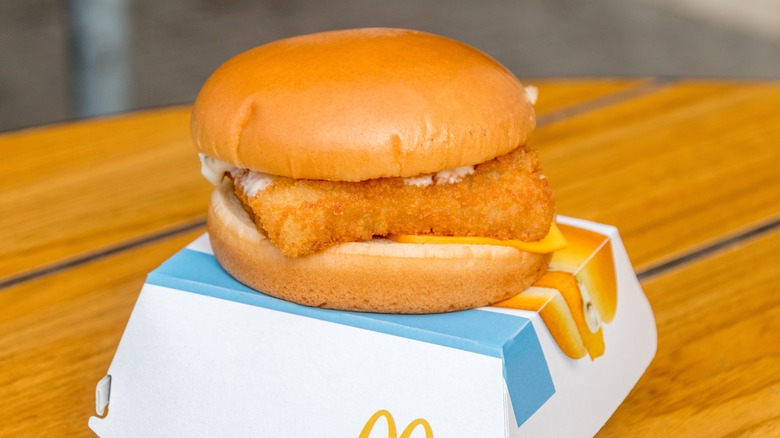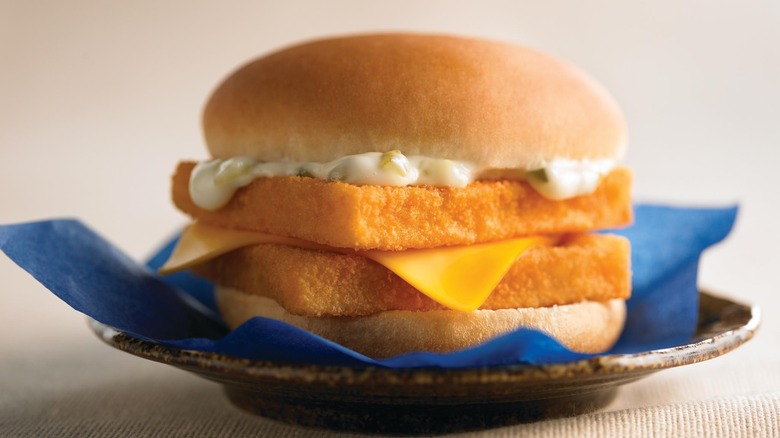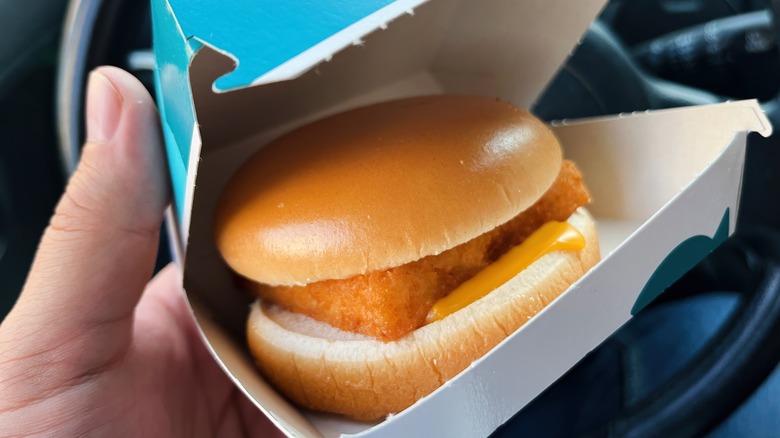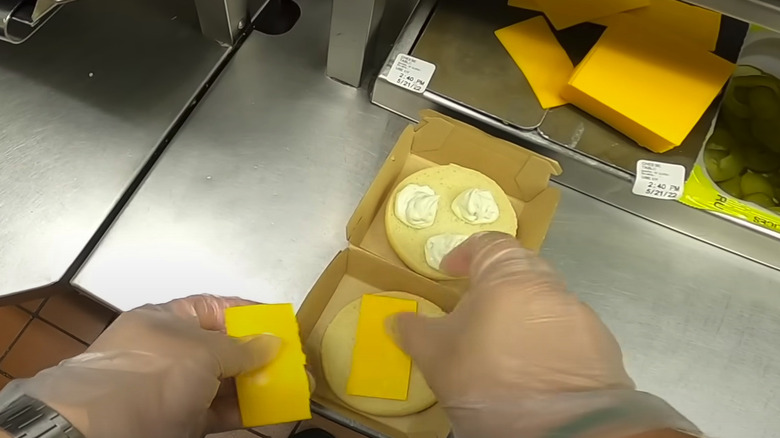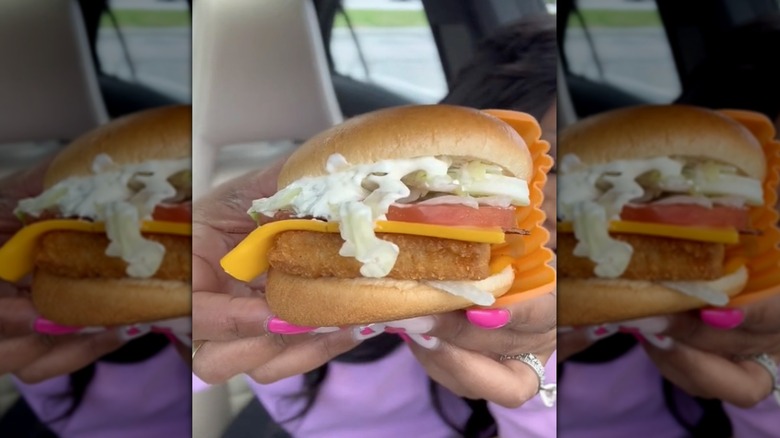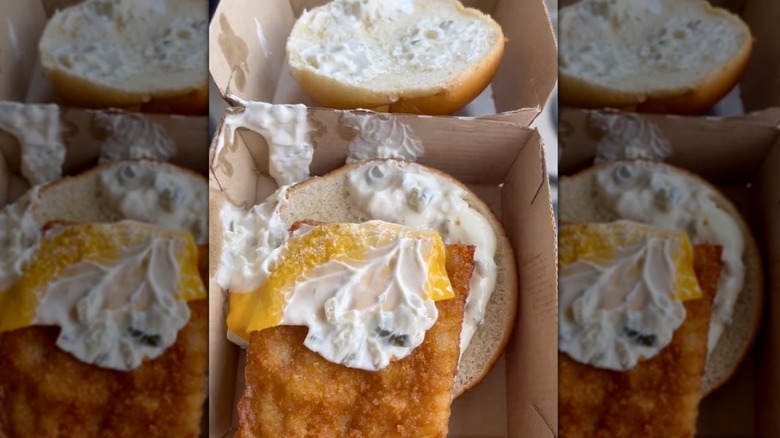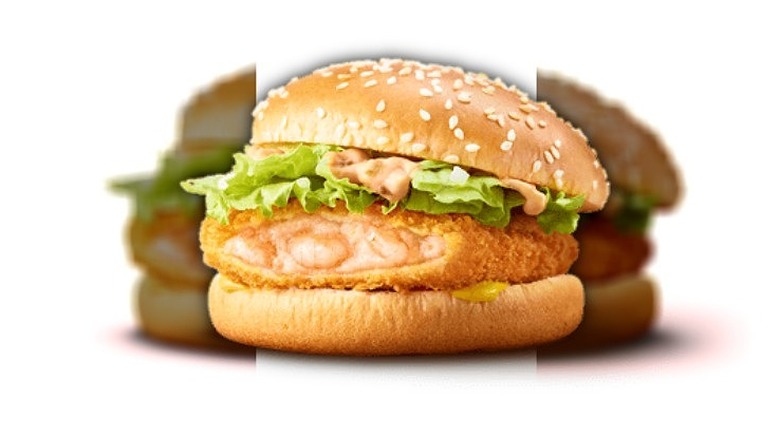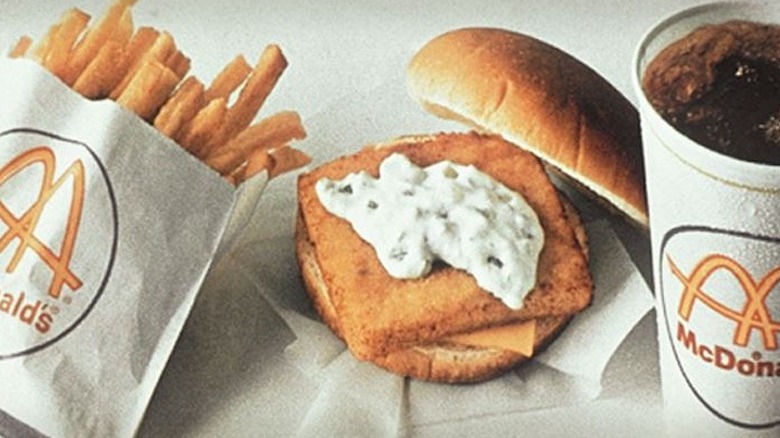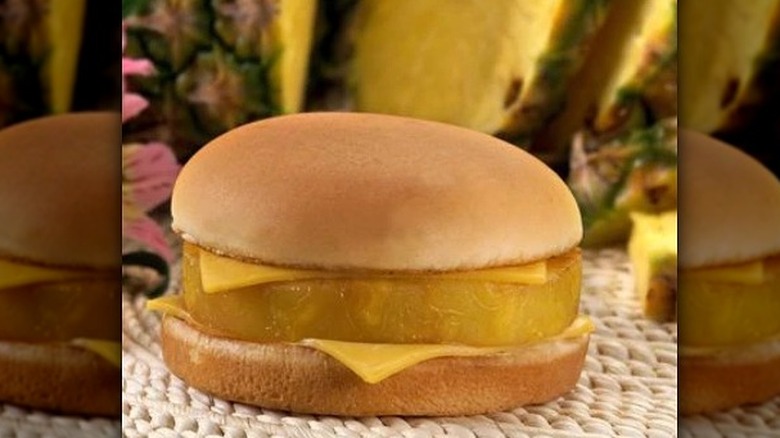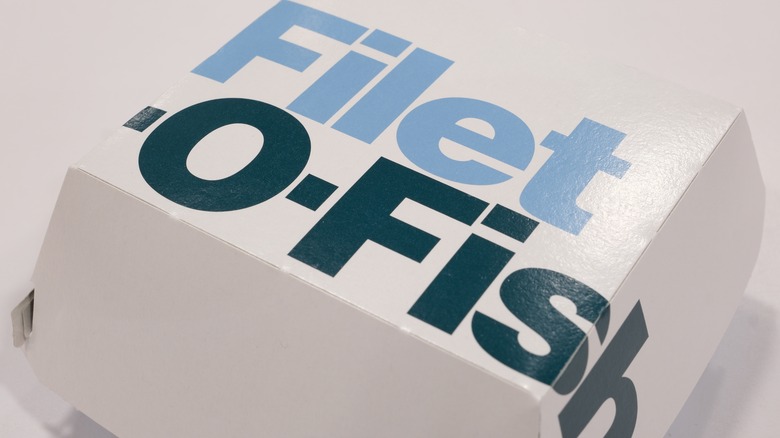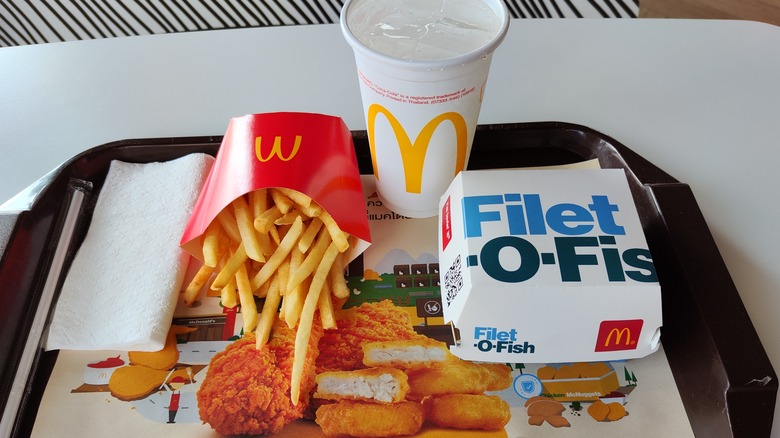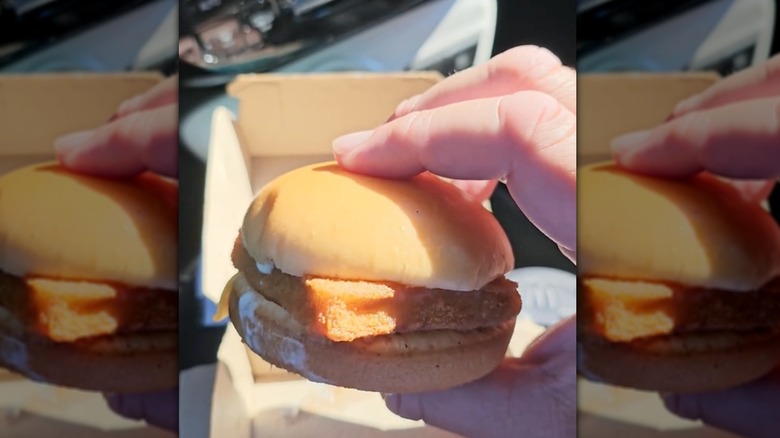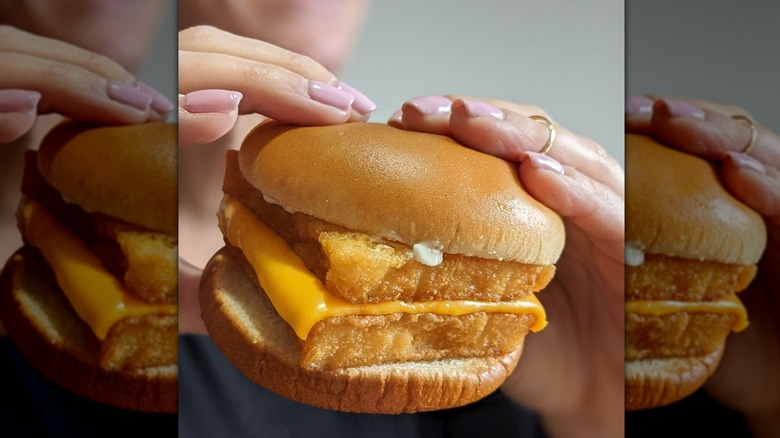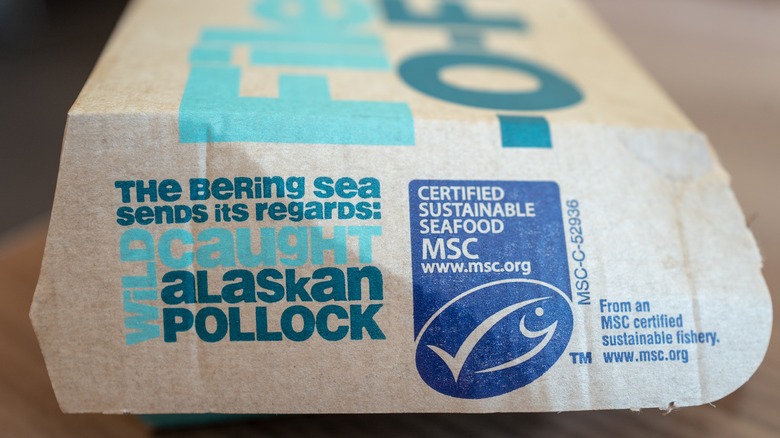14 Things About McDonald's Filet-O-Fish You Need To Know
When you think of McDonald's, there's a good chance you are thinking of burgers, French fries, and maybe even breakfast sandwiches. But these items are far from the only ones that got this famous fast food restaurant to one billion sold (and counting). There's a whole sect of people who don't opt for a meaty burger when visiting the house that Ronald built; instead, they cast their eyes on the Filet-O-Fish.
This simple fish sandwich has a long standing legacy with the brand. The Filet-O-Fish even once had a mascot to represent these sandwiches. This flamboyant figure was called Phil A. O'Fish, who premiered in 1976. He was dressed in a sailor suit and net (as though he were going to go fishing). Though you'd be hard pressed to find Phil anymore, the love for this sandwich certainly remains. But as with all things, the Filet-O-Fish has more to reveal, and after diving into the deep, we're willing to bet it may intrigue you enough to become part of your next McDonald's order.
It's a simple sandwich
As with so many things, the individual aspects of McDonald's Filet-O-Fish are far from what makes it interesting. Truth be told, it's really only a few ingredients. It's these simple pieces that make this sandwich an enjoyable option for many. It all starts with a steamed bun and three other pretty straight forward ingredients. You'll get a fish filet (the namesake), American cheese, and tartar sauce.
Compared to some other fish sandwiches on the market, this is quite on the simple side. Some include crunchy lettuce and even a tomato. Others go a little tart and include a ringer, like pickles, to help even out the fish. The only trouble with these pieces is that they make the whole experience a little trickier to eat. McDonald's, on the other hand, has that cheese melted to the fish and then the bun and fish attached with the tarter sauce acting as a kind of glue.
The bun is soft because it's steamed
Once you take a bite into a Filet-O-Fish sandwich, a thing you'll probably notice is that the bun feels very soft. Unlike most McDonald's sandwiches — or other fast food fish sandwiches — the Filet-O-Fish gets an extra special treatment. In fact, it is the only sandwich on the menu with a steamed bun, which offers a kind of ultra-soft feel.
The steamed bun is also the reason that you won't see these sandwiches wrapped in paper. If employees were to do that, you would risk the paper attaching to warm bun or even getting a super smashed sandwich. Instead, McDonald's contain the sandwiches in a small clamshell style boxes without the risk of your bun becoming attached to its wrapper.
If you happen to be a big fan of this style of bun, you can always request other sandwiches on the menu be made with it. It is worth noting, however, that the steamed bun may not feel or taste the same on other sandwiches as it does on the Filet-O-Fish. For example, the same bun on a cheeseburger might be too moist compared to the sesame-studded bun intended to hold a heavy patty.
You're not missing the rest of your cheese
One of the other unique aspects of the Filet-O-Fish recipe is that it only includes half of a slice of cheese. When McDonald's crew members assemble the sandwich, they are instructed to cut the cheese in half rather than use the full slice. It may seem like a cost saving opportunity, but this is not an instance of shrinkflation. Instead, it has everything to do with maintaining a balance of flavors.
With a Filet-O-Fish, cheese should not be the primary flavor that you get when you bite into the sandwich; it should be one of the supporting flavors with the fish making up a majority of the taste. This is why the half slice of cheese is so important. A full slice of cheese would overpower the fish. That said, you can request a full slice if the half is deeply upsetting to you.
Some other fast food chains seem to have caught on to customers' insecurities about the half slice of cheese. Burger King, for one, advertises that it uses a full slice of cheese on its website. Of course, Burger King's specification might just be throwing shade at the competitive golden arches.
You can hack the sandwich with modifications
Since the Filet-O-Fish is such a simple sandwich, it is ripe for making modifications to create a sandwich that feels perfectly suited to your tastes. One of the more simple modifications that customers like to make to the Filet-O-Fish is simply doubling up the Filet-O-Fish patty. Crew members may do it on their own, but you can ask for a full slice of cheese when you make a swap to ensure that there is enough cheese for each fish patty. You'll probably also want some extra tarter sauce just to ensure everything gets enough of that tasty coating.
For a sandwich that has a lot more going on with it than a regular filet of fish, order a Filet-O-Fish style BLT. There's a good chance that the crew member taking your order may not know exactly what you're referring to if you order it by name, so help them out by specifying a Filet-O-Fish with bacon, lettuce, and tomato added to it. If tartar sauce isn't your favorite sauce to enjoy with a sandwich, swap it out for Big Mac sauce. The Big Mac sauce will have zestyness that compliments a quality fish sandwich, but it'll will also have a an extra savory note, too.
The packaging process may lead to disheveled sandwiches
With fast food, customers often notice that the sandwiches just don't look like they do in the advertisements. There are many ways food photography is trying to fool you, a bunch of them stemming from the fact that advertising photos are meticulously created to make food look idealistic. Filet-O-Fish sandwiches are a different ball game. It's more than imperfection. Some of the sandwiches just show up wonky. Common things you might see are tarter sauce that has slid off center, or a filet out of position altogether.
These odd issues can happen for a few reasons, but one of them is quite simply the delivery and assembly process. To create these fishy favorites, the steamed bun is put on either side of the box, tartar sauce is added to one bun while the slice of cheese is added to the other.
If an assembly line setup is being used at your location, the box will then be passed to the next person who will put the filet on top of the tartar sauce, and then the McDonald's crew member will close the box, dropping the cheesed bun over the other side. In the process, the buns have the opportunity to slide around because the box is simply too big for its contained sandwich. This large box gives plenty of room for things to move about, ultimately creating a disheveled looking sandwich.
Japanese McDonald's locations harbor a relative to the Filet-O-Fish
There are many wonderful aspects of traveling to different countries, from enjoying aspects of a art and geography to seeing how people live their day-to-dat, and, of course, sampling the local cuisine. While fast food might not be the very first thing on your bucket list when visiting a new country, checking out the menu of some of your favorites from back home can reveal fun and interesting tastes you might not suspect.
McDonald's has locations in thousands of places around the world. Those menus can often be quite different. In Japan, for example, you can find an Ebi Filet-O, also known as a Shrimp Filet-O. This sandwich, which appears to be a cousin of the Americanized Filet-O-Fish, is a sandwich with a poppy seed bun as well as shredded lettuce, yellow mustard, and some kind of special sauce, all surrounding a patty made of shrimp. Like the Filet-O-Fish, which is a filet rather than a mashed conglomerant of chicken, the shrimp filet seems to have a great texture to it. The patty has real shrimp chunks, as it should.
Lou Groen invented the sandwich
Necessity is the mother of invention, and when early McDonald's-adopter Lou Groen noticed his sales dip dramatically during the Lenton season, he knew he needed to come up with a solution to draw Catholic customers back in on days when they were avoiding meat. Inspired by a competing restaurant, Frischs, Groen brought a halibut sandwich idea to Ray Kroc. Though the fish itself would change to another variety, the sandwich that's available today remains pretty similar to Groen's suggestion. It goes to show what franchisees bring to multinational corporation.
Groen had only been in the business a few years when he netted the legacy-worthy idea of the Filet-O-Fish. It was invented in 1962, three years after Groen opened the 66th McDonald's in 1959. Before it was known whether the sandwich would be popular or not, Groen had to advocated persistently to get the it on the menu. Following Groen's passing in 2011his granddaughter, Erica Shadoin, continues his legacy. She now owns 15 McDonald's in northern Kentucky and Cincinnati, and you can bet they sell some Filet-O-Fish
Ray Kroc tested the Filet-O-Fish against a Hula Burger
Lou Groen was so committed to his fish sandwich that he brought it to Ray Kroc. Initially, Kroc was not a fan of the fish sandwich idea, as he had notions for his own new sandwich. Eventually, Kroc decided to put Gruen's fish sandwich head-to-head with his idea for a Hula Burger. The reward was that whichever sandwich ended up selling more would find a place on the menu at McDonald's locations.
The Filet-O-Fish sandwich was much the same as it is today, but the Hula Burger was a completely different concept. This is a sandwich with a large chunk of pineapple between two slices of cheese, on a bun. The idea is that the meat is replaced with fruit, and while this would satisfy Catholics' need to avoid meat on Fridays in Lent, it may not have panned out so well in terms of taste. After the test sales between the two, the Filet-O-Fish sold 350 sandwiches while the Hula Burger clocked in at six, making the winner obvious and adding a bite of sea breeze to McDonald's menu.
Lent is a busy season for the Filet-O-Fish
When Lou Groen first created the Filet-O-Fish, he did so to address a major loss in revenue each year during the Lent season. Located in an area with a large margin of Catholic customers, he seemed confident that a Filet-O-Fish would perform well since, Catholics avoid eating meat on Fridays during Lent.
In total, Lent begins 46 days before Easter, but it only technically counts for 40 days. During this season, Catholics avoid meat on Fridays, so many opt to eat fish instead. The reason fish isn't considered meat during the Lent season goes back to 9th century definitions that says fish do not bleed, as cold-blooded creatures, don't count.
As a result, Filet-O-Fish becomes a popular menu item for Catholics during the season. The numbers are staggering. USA Today reports that McDonald's sells roughly 300 million Filet-O-Fish each year with 25% of those ordered from McDonald's during Lent alone.
Watch out for deals
Though McDonald's is already pretty inexpensive as far as a lunch or dinner goes, there's always room to save more. That's why we recommend looking out for deals, especially during Lent, when heading to the golden arches.
For instance, during the 46 days before Easter of 2024, you could purchase a Filet-O-Fish sandwich for only one dollar after the purchase of your first one. This promotion began on February 14 and lasted through March 28th. Put simply, McDonald's makes it as easy as possible for those wanting a fish sandwich during Lent. During the 2021 Lent season, McDonalds offered a 2 for $5 on the Filet-O-Fish sandwiches. These deals sometimes include other sandwiches.
For example, the mixing and matching with a few different offerings is something we see quite frequently. Typically, these will be two items for a set price, but that price will, of course, vary based on the items included.
There's some speculation it may have shrunk
Though McDonald's plans seem to go against shrinkflation, that doesn't mean customers are seeing it. In 2023, customers took to TikTok to claim that the sandwich feels, at least in one instance, according to neilybob, 20% smaller. Others called it so small it should be a slider.
To set the record straight, chef Mike Haracz, a former McDonald's corporate chef, visited a McDonald's himself to see if the claims had any gills. He found that while the sandwich is pretty much the same size, it is quite a bit more expensive than it once was. However, McDonald's debunks this claim, offering that the 2019 average price for customers of the Filet-O-Fish was $3.99, and in 2024, that went up 80 cents to $4.79. This is an increase of 20%, which is lower than the rate of inflation. Whether it's an example of augmenting video or images to suit needs, simply relatively large hand size, or even misremembering the size of the sandwich, it seems the Filet-O-Fish's shrinkflation only counts as speculation.
The square shape ensures consistency
When you purchase a fish sandwich at a sitdown restaurant or even a fish fry, there's a good chance you're getting a sandwich with a rather irregularly shaped and sized fish filet. However, when you order a Filet-O-Fish, it's going to be a breaded and fried square patty every time. The difference may be a little alarming, but there's actually a good reason for it.
Irregularly sized filets offer little consistency from sandwich to sandwich. It's hard to regulate the amount of sauce that will offer the perfect balance or even other condiments. This leads to a sort of guessing game. McDonald's, on the other hand, has offerings that are nearly identical every time you get them. This leads to impressive consistency from location to location, so you always know what to expect. And this is the reason the Filet-O-Fish is squared. The filets are stacked and cut into squares, allowing the brand to offer the same amount of fish, reasonably sized, and prepared in a method that suite mass retail.
The fish is pretty fresh
Though the original sandwich was halibut, now, it is Alaskan pollock. The fish is not from farms; rather, it is caught fresh. Then, the processing and preparation for the sandwiches begins right on the boat.
After catching the fish, it'll get processed and frozen while still out on the sea. According to Kenny Longaker, a fish supplier for McDonald's, that fish is frozen between 24 to 72 hours after it is caught on ships like Longaker's "The Defender" in The Bering Sea.
It's layered to create the larger pieces that will then go to a processing facility which cuts, breads, par-fries, and freezes the fish again. Though you might expect that the fish wouldn't look like actual, flaky fish inside, it does. This is quite different from the chicken nuggets, which are ground and then shaped. With the fish filets, you can see the flakey bits because it's fresh frozen fish.
Alaskan wild caught pollock may be on the decline
Because it doesn't necessarily look like fish when you look at the filet, you may wonder if the McDonald's Filet-O-Fish is real. Rest easy knowing that, yes, the filet is actually made of a fish called Alaskan pollock. Alaskan pollock is a type of cod. And they're rather small; rarely do they hit over three pounds and the length is typically one foot to 20 inches.
Left alone, these fish may live up to 12 years throughout the North Pacific Ocean and especially within the Bering Sea. Pollock is one of the largest fisheries in the world, but declines have been acknowledged across many populations, leading to concerns about the species. Even if you've never heard of pollock, there's a good chance that if you buy frozen fish from the grocery store, you've tried it. Many of the frozen fish filets you'll find in grocery stores are made of pollock, and it's also a prominent component of imitation crab meat.
